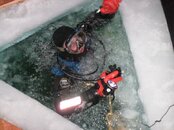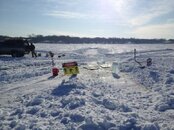BlackPatch
Registered
I don't know of anyone that doesn't view ice diving as serious. A good portion of learning to ice dive is getting the proper thermal protection and the proper scuba unit set-up. There are additional areas of training necessary such as avoiding stirring up the silt, dealing with freeflows, learning communication skills diver/tender, avoiding rapid ascents, but once you get past all that and get down to your depth, a dive is a dive. The skills are the same. From what I understand a lot of those that get the card for recreational purposes never go any further with it. To do it right and by the book you need a minimum of 5 people [2 divers, 2 tenders and a safety diver.] It is very hard to get that many people together for a frigid afternoon [3-4 hours] out on the ice. Many of those that become actively involved in ice diving on a regular basis are Fire/Police search/recovery types, vehicle-through-the-ice recovery personnel, scientific divers, etc. I imagine they all get extensive further training and practice.
As to the redundancy issue I think a pony at hand is mandatory. Most of the freeflows I have experienced have involved knobs and connections being fully encased in a 1/4" layer of ice while underwater. I have been unable to shut off valves or unhook freeflowing bcds. It sounds good on paper but these fixes don't always work in the real world. A successful ice diver has learned to acquire the proper gear to minimize these issues from occurring.
As a final note - just out of curiosity - what does it cost to become a significantly-trained cave diver? I bet it's a lot. Do all new cave divers come out of training significantly-trained. I am sorry if I sound like a wise-ass but it I don't know what the training involves or what the answer is.
Old Flounder.
I use my Drysuit as a secondary inflation source.
Typically I will keep my shoulder vent open all the time so I can role slightly to vent.
My primary Buoyancy control is through my BCD. When it is time to come up, I will vent as much of the gas in my Drysuit as possible to maintain good buoyancy characteristics on ascent.
Yes, I put up with the squeeze. That's the way I do it and it works for me in Alberta fresh water lakes that are fairly Cold.
What you are describing is basically an uncontrolled ascent (am I right?) in the fact that you were being pulled to the surface. I forget the ratios that the vents can handle but I think it is 18lpm. So you didn't have a chance.
As you have already mentioned, you were not in an emergency. You didn't have clear cut comms signals defined or per planned use of those. It's a lesson more than how you dealt with the Situation.
As I see it Buddy, you did a good job, You did not have clear vis of the issue, No Effective Comms System. Get the bloke lassy to the top. THEY (not other people who were not in your shoes at THAT EXACT SECOND) can chew your ass off if they think it was uncalled for!
Bottom line. Even in Class, plan for all eventualities. But then again you know that mate, you and pretty much everyone else who has posted here, has far greater experience Diving than I.
Stay Safe and Props.
Pete.



 Yesterday we were diving a sunken fish house under the ice. When I loaded my backplate/wings into the truck, some water poured out. I then realized my dump valve had come undone! I completed 2 dives without knowing!:doh:
Yesterday we were diving a sunken fish house under the ice. When I loaded my backplate/wings into the truck, some water poured out. I then realized my dump valve had come undone! I completed 2 dives without knowing!:doh:

